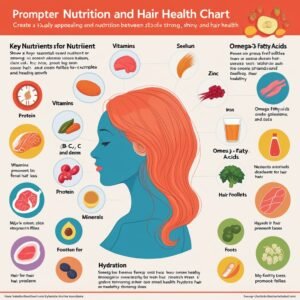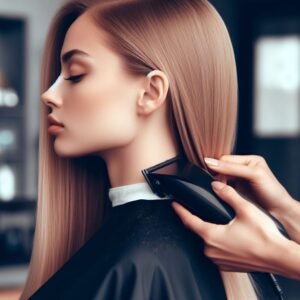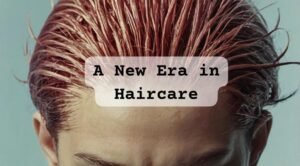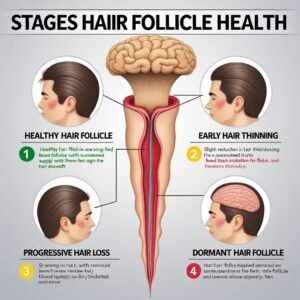
Before heat styling, we need to known Hair styles:
Sorts of haircuts
Hair styling incorporates a large number of strategies and techniques to maneuver hair toward various shapes, surfaces, and structures. Here are a few critical parts of hair styling:
1.Hair Cutting:
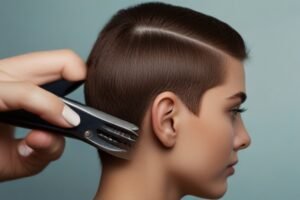 This includes managing or forming hair to achieve a particular length or style. Different cutting procedures, for example, layering, texturizing, or obtuse cuts, can give different looks.
This includes managing or forming hair to achieve a particular length or style. Different cutting procedures, for example, layering, texturizing, or obtuse cuts, can give different looks.
Which haircut reduces hair fall?
Since there isn’t a certain haircut that will stop hair loss entirely, choosing shorter styles can occasionally make hair look thicker, which may give the appearance that less hair falls. Furthermore, minimizing hair fall can be achieved by upholding a healthy scalp and a general hair care regimen, which includes frequent washing, conditioning, and refraining from overusing heat styling.
2.Hair coloring:
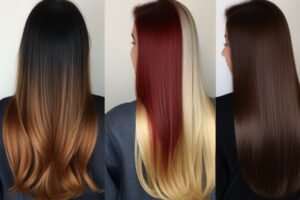 Shading procedures like features, balayage, ombre, or full tone can change the hair’s tint and add aspect. Proficient colorists use colors and fades to achieve desired shades and impacts.
Shading procedures like features, balayage, ombre, or full tone can change the hair’s tint and add aspect. Proficient colorists use colors and fades to achieve desired shades and impacts.
3.Hair Surface Manipulation:
 Hair can be styled to modify its regular surface, for example, with hair curling accessories for making twists or level irons for fixing. Perms or relaxers can forever change the hair’s surface.
Hair can be styled to modify its regular surface, for example, with hair curling accessories for making twists or level irons for fixing. Perms or relaxers can forever change the hair’s surface.
4. Hair products:
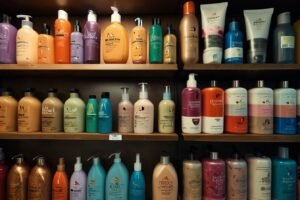 Different styling items like gel, mousse, grease, wax, or hairspray are utilized to shape, hold, and add try-to-please. These items give various degrees of hold and finish to suit various styles and hair types.
Different styling items like gel, mousse, grease, wax, or hairspray are utilized to shape, hold, and add try-to-please. These items give various degrees of hold and finish to suit various styles and hair types.
5.Hair styling Tools:
 Instruments like hairdryers, straighteners, hair curlers, round brushes, brushes, and clips are fundamental for making explicit hairdos. High-level instruments like diffusers or hot rollers can likewise be utilized for additional specific looks.
Instruments like hairdryers, straighteners, hair curlers, round brushes, brushes, and clips are fundamental for making explicit hairdos. High-level instruments like diffusers or hot rollers can likewise be utilized for additional specific looks.
6. Hair Styling Techniques:
 Various procedures, for example, blow drying, interlacing, bending, or prodding, are utilized to accomplish explicit styles like up dos, plaits, braids, or buns.
Various procedures, for example, blow drying, interlacing, bending, or prodding, are utilized to accomplish explicit styles like up dos, plaits, braids, or buns.
7.Face Shape and Hair Type Consideration:
 Beauticians frequently consider factors like face shape, hair type (straight, wavy, wavy), and hair length while prescribing or making hairdos to guarantee the most complimenting results. Generally, hair styling is a flexible and inventive flow that permits people to communicate their character and upgrade their appearance through their hair. Proficient beauticians go through the process of preparing to dominate different methods and remain refreshed with the most recent patterns and developments in the business.
Beauticians frequently consider factors like face shape, hair type (straight, wavy, wavy), and hair length while prescribing or making hairdos to guarantee the most complimenting results. Generally, hair styling is a flexible and inventive flow that permits people to communicate their character and upgrade their appearance through their hair. Proficient beauticians go through the process of preparing to dominate different methods and remain refreshed with the most recent patterns and developments in the business.
Heat styling without damaging Hair :
Heat styling can assist you with accomplishing the ideal search for your hair, yet it’s fundamental to cause it right to limit harm. Here are a few hints to safeguard your hair while utilizing heat styling devices:
How can I style my hair with heat without damaging it?
Start by spraying or serum-bathing your hair with a heat protectant to style it with heat without damaging it. To minimize overheating, adjust the heat on your styling tool to a lower setting. To reduce heat damage, think about adopting other style techniques like air drying or heatless curls.
1. Choose Great Tools:
Settle on a high-quality fixing or twisting iron produced using materials like fired, tourmaline, or titanium. Modest irons with lopsided warming can really consume your hair. Select the right iron size in light of your hair length and thickness. A 1-inch iron is flexible for medium-length hair, while more modest or bigger irons work for more limited or thicker hair individually.
2. Apply intensity protection:
Utilize an intensity protectant prior to styling. Search for items containing the two humectants (like panthenol and propylene glycol) and silicones (like amodimethicone and dimethicone). These fixings secure in dampness and protect your hair from heat. **Dry your hair completely** prior to utilizing heat devices. Set your blow dryer to the lowest setting and separate thick hair into areas if needed.
3. Adjust Temperature:
Begin at a low temperature and continuously increment if vital. Utilize an iron with advanced temperature control for accuracy. Temperatures going from 175°F (79°C) to 400°F (204°C) work for most hair types. Coarse or safe hair might require higher temperatures.
4. Take Breaks:
Keep away from day-to-day heat styling. Offer your hair a reprieve no less than once each week. Allow it to air dry normally to recuperate from heat exposure.
Do you have any recommendations for products or techniques to protect hair from heat damage while using styling tools?
Surely! The following advice will help shield your hair from heat damage while using styling tools:
1. Heat protectant: To protect your hair from heat, use a spray or serum.
2. Lower heat: Use styling tools at reduced temperatures.
3. Tool material: For uniform heat distribution, use ceramic or tourmaline tools.
4. Moderate use: Restrict the frequency of heat styling sessions.
5. Conditioning: To maintain healthy hair, use deep conditioning treatments.
6.Air dry: Prior to styling, let your hair dry naturally.
Tips for safely using curling Irons and Flat Irons:
To limit harm while heat styling your hair, attempt these tips:
Can you provide a step-by-step guide for safely using curly irons and flat irons?
1.Utilize an intensity- protectant shower or serum prior to styling to create a boundary between your hair and the intensity.B
2.Bring down the intensity setting on your styling devices. High temperatures can cause more harm, so begin with a lower setting and steadily increment if necessary.
3.Limit heat openness by styling your hair less regularly. Embrace air-drying or select heatless styling techniques whenever the situation allows.
4.Put resources into great styling devices with clay or tourmaline plates, which disperse heat all the more equally and decrease harm.
5. Utilize a wide-tooth brush or a brush explicitly intended for wet hair to detangle prior to styling, as wet hair is more inclined to harm.
6. Abstain from holding the styling apparatus in one spot for a really long time. Keep it moving to uniformly circulate the intensity.
How do you use a curling iron for beginners?
First-time curling iron users may find it complicated, but that follows is a simple guide:
1. Apply heat protectant to your hair.
2. Separate into groups.
3. Curl little pieces away from the face.
4. Hold and release after 5–10 seconds.
5. Take different routes.
6. Allow curls to cool.
7. Apply hairspray to finish.

